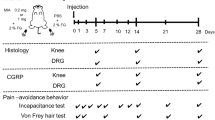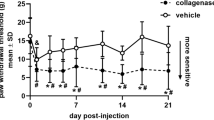Abstract
Background
Osteoarthritis arising from cartilage degeneration is the most common cause of joint pain. However, the relationship between joint pain and cartilage degeneration is not well understood.
Questions/Purposes
We asked whether the inflammatory mediators participate in the joint pain in the presence of cartilage degeneration.
Methods
We observed electromyographic responses of hindlimb flexors to four inflammatory mediators (bradykinin, ATP, acetylcholine, and serotonin) injected in normal rat knees and in those with monosodium iodoacetate (MIA)-induced arthritis.
Results
Joint cartilage of all the rats with MIA-induced arthritis histologically showed severe degeneration. We observed greater magnitude and longer duration responses in the MIA-induced arthritis than normal joints with all four mediators.
Conclusions
The data suggested nociceptors in osteoarthritic joints are more sensitive to inflammatory mediators than in normal joints. Such nociceptive sensitization to inflammatory mediators may participate in the joint pain in osteoarthritis.





Similar content being viewed by others
References
Alstergren P, Kopp S. Pain and synovial fluid concentration of serotonin in arthritic temporomandibular joints. Pain. 1997;72:137–143.
Birrell GJ, McQueen DS, Iggo A, Grubb BD. The effects of 5-HT on articular sensory receptors in normal and arthritic rats. Br J Pharmacol. 1990;101:715–721.
Combe R, Bramwell S, Field MJ. The monosodium iodoacetate model of osteoarthritis: a model of chronic nociceptive pain in rats? Neurosci Lett. 2004;370:236–240.
Dowd E, McQueen DS, Chessell IP, Humphrey PP. P2X receptor-mediated excitation of nociceptive afferents in the normal and arthritic rat knee joint. Br J Pharmacol. 1998;125:341–346.
Egan CG, Lockhart JC, Ferrell WR. Pathophysiology of vascular dysfunction in a rat model of chronic joint inflammation. J Physiol. 2004;557:635–643.
Guerrero AT, Verri WA Jr, Cuna TM, Silva TA, Rocha FA, Ferreira SH, Cunha FQ, Parada CA. Hypernociception elicited by tibio-tarsal joint flexion in mice: a novel experimental arthritis model for pharmacological screening. Pharmacol Biochem Behav. 2006;84:244–251.
Gwilym SE, Pollard TC, Carr AJ. Understanding pain in osteoarthritis. J Bone Joint Surg Br. 2008;90:280–287.
Hamilton SG, McMahon SB. ATP as peripheral mediator of pain. J Auton Nerv Syst. 2000;81:187–194.
Herbert MK, Schmidt RF. Activation of normal and inflamed fine articular afferent units by serotonin. Pain. 1992;50:79–88.
Joseph EK, Chen X, Bogen O, Levine JD. Oxaliplatin acts on IB4-positive nociceptors to induce an oxidative stress-dependent acute painful peripheral neuropathy. J Pain. 2008;9:463–472.
Juan H, Lembeck F. Action of peptides and other algesic agents on paravascular pain receptors of the isolated perfused rabbit ear. Naunyn Schmiedebergs Arch Pharmacol. 1974;283:151–164.
Kanaka R, Schaible HG, Schmidt RF. Activation of fine articular afferent units by bradykinin. Brain Res. 1985;327:81–90.
Kobayashi K, Imaizumi R, Sumichika H, Tanaka H, Goda M, Fukunari A, Komatsu H. Sodium iodoacetate-induced experimental osteoarthritis and associated pain model in rats. J Vet Med Sci. 2003;65:1195–1199.
Kumazawa T. The polymodal receptor: bio-warning and defense system. Prog Brain Res. 1996;113:3–18.
Lang PM, Burgstahler R, Sippel W, Irnich D, Schlotter-Weigel B, Grafe P. Characterization of neuronal nicotinic acetylcholine receptors in the membrane of unmyelinated human c-fiber axons by in vitro studies. J Neurophysiol. 2003;90:3295–3303.
Melmon KL, Webster ME, Goldfinger SE, Seegmiller JE. The presence of a kinin in inflammatory synovial effusion from arthritides of varying etologies. Arthritis Rheum. 1967;10:13–20.
Okamoto M, Atsuta Y, Machida K. Pain-generating properties of chemical mediators in normal and osteoarthritic knee joints of rats. Transactions of the 52nd Annual Meeting of the Orthopaedic Research Society. Paper No 1533. 2006:113. Available at: http://www.ors.org/web/Transactions/52/1533.PDF. Accessed November 30, 2009.
Okamoto T, Atsuta Y, Shimazaki S. Sensory afferent properties of immobilised or inflamed rat knees during continuous passive movement. J Bone Joint Surg Br. 1999;81:171–177.
Park W, Masuda I, Cardenal-Escarcena A, Palmer DL, McCarty DJ. Inorganic pyrophosphate generation from adenosine triphosphate by cell-free human synovial fluid. J Rheumatol. 1996;23:665–671.
Schaible HG, Ebersberger A, Von Banchet GS. Mechanisms of pain in arthritis. Ann NY Acad Sci. 2002;966:343–354.
Schaible HG, Grubb BD. Afferent and spinal mechanisms of joint pain. Pain. 1993;55:5–54.
Skljarevski V, Ramadan NM. The nociceptive flexion reflex in humans: review article. Pain. 2002;96:3–8.
Willer JC. Nociceptive flexion reflexes as a tool for pain research in man. Adv Neurol. 1983;39:809–827.
Wood JN, Docherty R. Mediator activators of sensory neurons. Annu Rev Physiol. 1997;59:457–482.
Yamashita I, Atsuta Y, Shimazaki S, Miyatsu M. [Effects of prostaglandin E2 and sodium hyaluronate on bradykinin induced knee joint pain in rat] [in Japanese]. Nippon Seikeigeka Gakkai Zasshi. 1995;69:735–743.
Author information
Authors and Affiliations
Corresponding author
Additional information
Each author certifies that he or she has no commercial associations (eg, consultancies, stock ownership, equity interest, patent/licensing arrangements, etc) that might pose a conflict of interest in connection with the submitted article.
Each author certifies that his or her institution approved the animal protocol for this investigation and that all investigations were conducted in conformity with ethical principles of research.
About this article
Cite this article
Okamoto, M., Atsuta, Y. Cartilage Degeneration is Associated with Augmented Chemically-induced Joint Pain in Rats: A Pilot Study. Clin Orthop Relat Res 468, 1423–1427 (2010). https://doi.org/10.1007/s11999-009-1193-z
Received:
Accepted:
Published:
Issue Date:
DOI: https://doi.org/10.1007/s11999-009-1193-z




